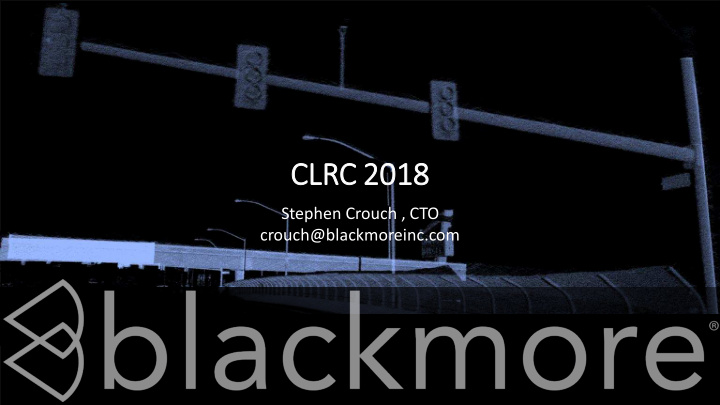



CLR LRC 20 2018 18 Stephen Crouch , CTO crouch@blackmoreinc.com
Intro • Founded in 2016 ‒ Bozeman, MT • Initially contract RnD heavy • Developed HRS product as a long-range 3D imaging solution ‒ Long development cycle ‒ Important experience 2
Long Range 3
High Resolution 4
Fieldable 3D Imager 5
Then we asked questions… • What if this was “real time”? • What if we traded range for point throughput? • What needed to change for automotive scenarios? • What if we could leverage trends in telecom to shrink the design? We experimented and we gathered information 6
AD/ADAS Market • Billions invested in autonomous technology • Huge uncertainty for automotive OEMs • Simultaneous price and performance pressure • Hype becoming reality 7
Lidar’s “Moment” • Recognized as critical sensor for AD ‒ “Poor” performance limits role to localization ‒ Target performance will increase role Automakers are asking • Key performance targets for hundreds of ‒ 200m off 10% diffuse reflector thousands of lidar units ‒ Millions of points/sec ‒ 360 o coverage, may use multiple sensors by early 2020s • Deployment targets ‒ Automotive qualification ‒ CHEAP (<$1k / vehicle) 8
Performance Barrier Eyesafety • Point throughput and Barrier range are tough specs for any technology Coherent and • Pulsed, 1550nm systems Geiger-Mode Sensitivity are the only direct Interference detect systems that can Barrier hit specs Not OK ‒ More eye-safe for Auto! Direct Detect • Are pulsed fiber lasers Lidar Stuck Here scalable? Do they meet auto temperature specs? Transmit Power 9
Critical Auto Sensor Tech Chips are the building blocks of sensors, Lidar has to go chip scale GPS/IMU Vision Radar 10
Coherent Lidar Chips Photon efficiency hits specs w/ low transmit power Low power allows integration across temperature Photonic integration drops cost Added bonus: Doppler sensitivity Interference rejection properties 11
Blackmore Today • Building, shipping systems and integrating as we go • Grown from 5 to 55 employees • Recent Series B fundraise includes: 12
Proving the Advantages Item Specification Max Range (10% 200m (10% refl.) reflectivity) >450m range window Point Throughput Modes 300kpts/s standard, up to 1.2Mpts/s Velocity Dynamic Range +/- 100m/s Velocity Resolution 0.25 m/s FOV 40 o Hx 40 o V Wavelength 1550nm Output Power 100mW CW Next generation: 3x HFOV Eyesafety Class 1 (ANSI Z136.1- 2014, IEC 60825-1:2014) and 4x point throughput 13
Mobile Testing • Systems testing on the road for >18 months • Critical internal feedback 14
Long Range Performance (waiting at a red light) Structure @ 400m In-N-Out Burger Sign @ 200m Vehicle Location Gives autonomous systems plenty of range for smooth braking 15
Range Performance Height (Altitude) Coloration 16
High Speed Performance Height (Altitude) Coloration Doppler Not an Issue at Highway Speeds 17
Mapping Coverage Doppler supports simple removal of all transient objects in the map – accelerates map production and quality 18
Pedestrian Stride in Doppler Field 19
Point-by-Point Velocity Velocity Coloration Direct velocity measurement enables segmentation and tracking of moving objects 20
Point-by-Point Velocity Velocity Coloration Moving targets in dense urban environments are easily segmented and tracked 21
Dense Pedestrian Tracks Find and track pedestrians with much simpler algorithms 22
Working With Partners • Coherent lidar has a long history of “borrowing” telecom components ‒ Extremely mature supply chain • Blackmore working with coherent telecom vendors to customize lidar specific components ‒ Coherent optical comm now mainstream ‒ Vendors hungry for new opportunities ‒ Key differences: linewidth, bandwidth • Photonic integration critical to long term cost reduction 23
Investing in Technology • Low power, CW coherent lidar is inherently silicon photonics friendly • Working with Sandia National Labs to develop Silicon photonics solid state scanning technology • Currently testing chips 24
Conclusions • Autonomous driving forcing lidar to “grow up fast” ‒ More lidar systems will be built in 2019 than in history of lidar ‒ Comparisons to telecom boom, digital cameras, automotive radar, etc. • Automotive markets require development time and supply chain redundancy ‒ Leverage existing supply chains where they exist ‒ Invest in technology gaps with partners Coherent is in the game 25
Thank You! crouch@blackmoreinc.com
Recommend
More recommend